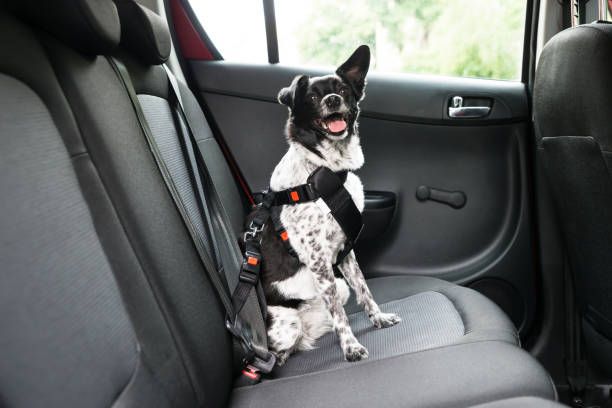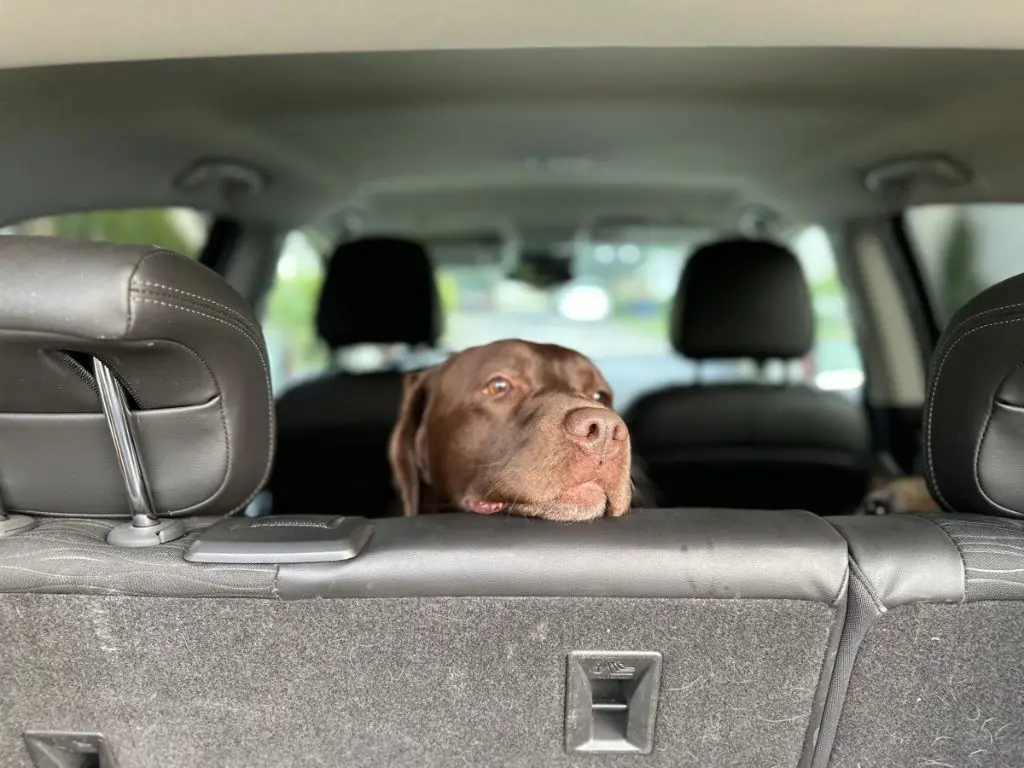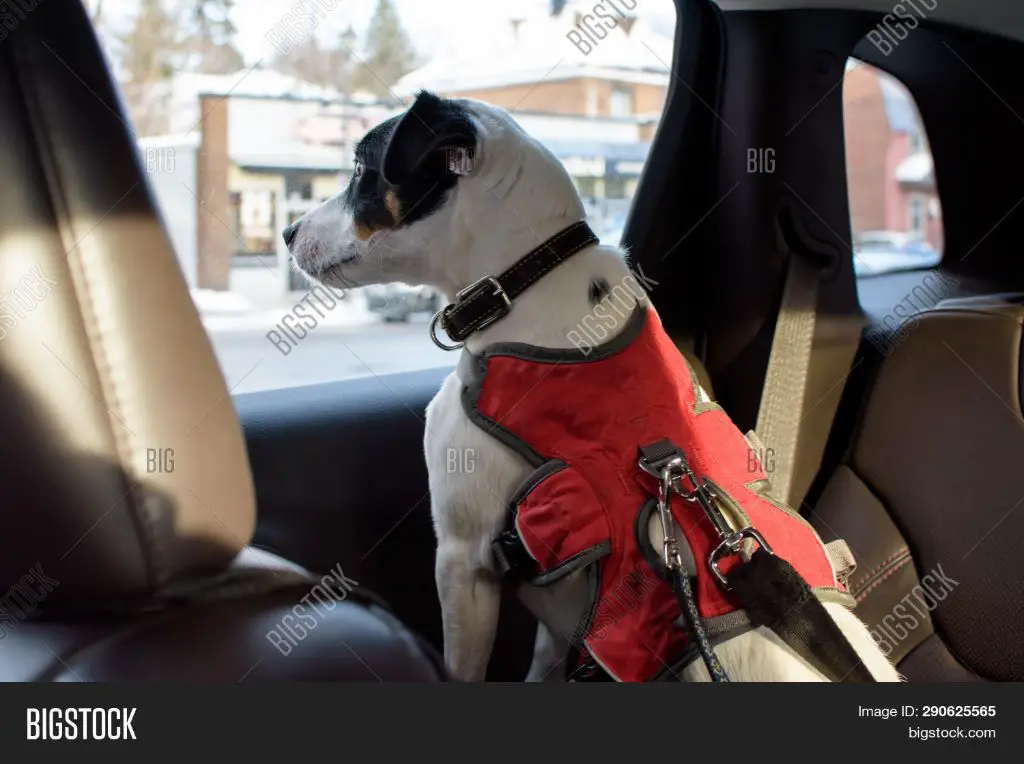Introduction: Dogs Love Car Rides, But It’s Important to Keep Them Safe
Riding in the car is a favorite activity for most dogs. In fact, according to the American Kennel Club (AKC), around 60 percent of pet owners drive with their dog in the car at least once a week. With millions of dogs riding in vehicles every day, it’s critical for owners to learn how to transport their furry friends safely and legally.
Safety Concerns
One of the main safety risks of having a loose dog in a moving vehicle is the potential for driver distraction. An unrestrained dog can easily climb into the driver’s lap, stand on the center console, or move around erratically in the backseat. This movement is highly distracting and dangerous, as the driver is likely to take their eyes off the road frequently to monitor the dog. Even a well-behaved dog may get excited or anxious during car rides and accidentally interfere with the driver’s ability to control the vehicle. Tragically, distracted driving due to an unrestrained pet is a common cause of serious auto accidents each year.
There is also a major risk of injury to the dog itself if it is loose in a moving car. Sudden braking can cause an unrestrained dog to be thrown hard against the windshield, dashboard, seatbacks, or doors. Unrestrained pets have suffered concussions, fractures, and even death in auto accidents. Letting a dog have free range of a moving vehicle puts the dog in grave danger during any emergency maneuver or collision.
Additionally, a loose dog can interfere with the proper functioning of airbags and safety systems. Most airbags are designed and calibrated for human passengers wearing seatbelts. A dog resting on the passenger seat or dash can be injured or killed by a forcefully deploying airbag. The presence of a loose pet can also block airbags from functioning as intended to protect passengers. Similarly, a dog moving freely alters the total weight distribution inside the car, which safety and collision detection systems are programmed to expect within normal limits.
Legal Requirements
There are laws in most states that require dogs to be properly restrained when traveling in vehicles. This is for the safety of both the dog and human occupants of the car.
Most state laws require dogs to be in a secured crate or carrier that is belted in, or wearing a seatbelt harness connected to the car’s seatbelt system. Having an unrestrained dog loose in the car is illegal in many states, even if they are in the backseat.
If an unrestrained dog causes an accident, you may face charges and fines. An unrestrained dog can also become a projectile in a crash, potentially injuring or even killing human passengers.
Check your local laws to understand the specific legal requirements for restraining dogs in cars in your state. Many states require restraint, but the exact regulations vary. Failure to properly restrain your dog risks injury as well as legal penalties.
Recommended Positions
When it comes to where dogs should sit in the car, experts generally recommend having dogs in the backseat or cargo area whenever possible. The backseat or cargo area allows you to secure your dog properly and also reduces distractions that could lead to accidents.
Specifically, the recommended positions for dogs in vehicles are:
- Back seat – Dogs should be secured in the back seat, either with a dog seatbelt or crate designed for car travel. The back seat keeps your dog out of the front, away from airbags and allows you to interact with them if needed.
- Cargo area – For SUVs, hatchbacks and wagons with cargo space, dogs can also travel safely in a properly secured crate or carrier in the back. The cargo area keeps them confined while in transit.
- Floor – Small dogs may be ok on the floor in the back seat but should be in a carrier. The floor keeps them low and stable.
- Front seat – Experts do not recommend having unrestrained dogs in the front seat. Airbags, distraction and movement make the front seat hazardous.

Picking the right position in the backseat or cargo area allows you to properly secure your dog for safety and minimize driving distractions.
Using Seatbelts
Seatbelts are an effective way to secure dogs while driving. There are a few options for using seatbelts:
Harnesses with seatbelt attachments – Many dog harnesses come with a strap or loop that attaches to the seatbelt. This keeps the dog restrained in case of sudden stops or accidents. Make sure to get a proper fit for maximum safety.
Seatbelt buckle attachments – These devices allow you to buckle your dog’s harness or collar directly into the car’s seatbelt buckle. They keep the dog secured to the seat while giving some freedom of movement.
Dog seatbelt leashes – These specially designed leashes attach to the car’s seatbelt receiver on one end and to the dog’s harness on the other end. They function like a seatbelt for the dog and prevent roaming around the car.
When using any kind of seatbelt for dogs, proper fit is important. Make sure the restraint is snug enough to keep the dog secure but not so tight as to be uncomfortable. Allow enough slack for the dog to sit, stand, and lay down comfortably.
Using Crates
Crates are one of the safest and most secure ways to transport dogs in vehicles. When used properly, crates keep dogs confined, minimize distractions, and protect dogs in the event of a sudden stop or accident. Here are some key benefits and tips for using crates for dogs in cars:
Benefits of Using Crates
- Prevents dogs from roaming freely and distracting the driver
- Contains mess and shedding fur to a confined area
- Provides protection in accidents by preventing ejection or impact with vehicle interior
- Offers comfort and security for anxious dogs
- Allows for water and toys to be kept nearby
Proper Crate Usage
- Ensure the crate is sturdy, escape-proof, and appropriately sized for the dog
- Secure the crate so it doesn’t shift or move while driving
- Pad the crate for comfort and include familiar toys/blankets
- Never leave dogs unattended for long periods in crates
- Maintain ventilation and moderate temperature
- Keep the crate out of direct sun, away from air vents

When used properly, crates are a safe and effective way to transport dogs in vehicles.
Distracted Driving
Having an unrestrained dog in the car can lead to distracted driving, which puts everyone in the vehicle at risk. Dogs that are loose in the cabin may try to climb into the driver’s lap, stick their head out the window, or generally move around in a distracting way. This forces the driver to split their attention between controlling the vehicle and monitoring the dog’s behavior. Even well-behaved dogs can accidentally cause distractions.
Studies show that distracted driving significantly slows reaction times and impairs driving abilities in the same way that texting or intoxication does. With an unrestrained dog in the vehicle, drivers are much more likely to cause accidents, not see pedestrians or other vehicles in time to react safely, drift out of their lane, or fail to stop appropriately. The consequences of accidents caused by distracted driving can be dire and potentially fatal for both humans and unrestrained pets.
To avoid distracted driving dangers, it is essential to secure dogs properly in the car so they cannot freely roam around the cabin. Safe restraint options like crates, carriers, and seatbelts allow dogs to ride without distracting or endangering the driver. Taking steps to minimize driving distractions keeps all passengers safe.
Airbag Hazards
Airbags pose a significant risk to unrestrained dogs in the front seat. When an airbag deploys in an accident, it does so with tremendous force and speed. This can severely injure or even kill a dog located in the direct path of the airbag.
According to tests, airbags deploy at around 200 miles per hour, so any pet located right in front of an airbag is likely to absorb the full brunt of that force. The impact could break bones, crush internal organs, or cause other life-threatening injuries.
Airbag deployment also releases hot gases that can burn a dog’s face or eyes if they are positioned too close. Additionally, the loud noise of airbag deployment can damage sensitive canine hearing.
For these reasons, it is never recommended to allow your dog to ride unrestrained in the front passenger seat, as they are directly in the path of any potential airbag deployment. The back seat is a much safer option.
Training Tips
Training and acclimating your dog to car rides is important for ensuring their safety and keeping them calm while driving. Here are some tips:

-
Take them on short trips first – Start with just going around the block and work up to longer rides. Give rewards during and after successful trips.
-
Use their crate – Let them get used to hanging out in their crate in the car before driving anywhere. Give them a favorite toy or chew inside.
-
Practice getting in and out – Open and close the door many times while they are nearby so the motion doesn’t startle them.
-
Reward calm behavior – If they are anxiously whining or pacing, wait until they settle down before moving the car and then praise/treat them.
-
Take breaks on long trips – Stop every 1-2 hours on road trips so they can get out, stretch their legs, and relieve themselves.
-
Manage motion sickness – Consult your vet if your dog gets sick. They may recommend medication, not feeding right before travel, or using a crate.
With time and positive reinforcement, you can make car rides an enjoyable experience for your dog rather than a stressful one.
Conclusion
Whether required by law or not, it is critical that dog owners properly restrain their pets when driving for everyone’s safety. As we’ve discussed, unrestrained dogs can be a dangerous distraction and are at risk of injury in a collision. By using dog seatbelts, harnesses, crates, and barriers, you can keep your dog secure and minimize hazards. Despite some dogs’ reluctance for confinement, try your best to keep them in one position for the entire ride. With patience and positive reinforcement, dogs can become accustomed to car restraints. Proper training is key – start when your dog is young to set good car manners. By following best practices, you are ensuring the wellbeing of your pet and reducing driving distractions. Safe travels with your furry companion!
